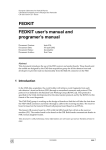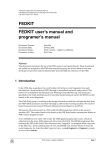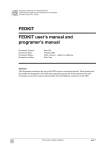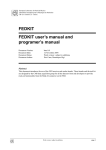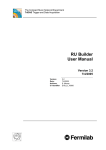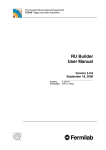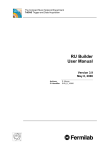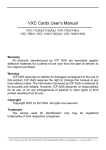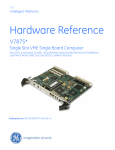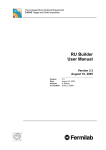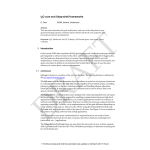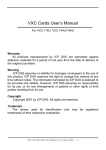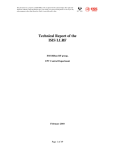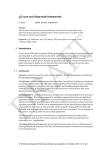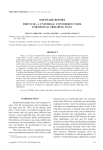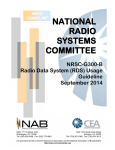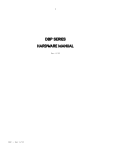Download FEDKIT FEDKIT user`s manual and programer`s manual
Transcript
European Laboratory for Particle Physics Laboratoire Européen pour la Physique des Particules CH-1211 Genève 23 - Suisse FEDKIT FEDKIT user’s manual and programer’s manual Document Version: Document Date: Document Status: Document Author: beta 0.3c 15 May 2002 Work version / subject to additions Eric Cano Abstract This document introduces the use of the FED receiver and sender boards. Those boards and the toolkit are designed by the CMS data acquisition group for all the detector front end developers to provide read-out functionality from the Slink-64 connector on the FED. 1 Introduction In the CMS data acquisition, the event builder will retrieve event fragments from each sub-detector’s front end driver (FED) through a normalised connector and protocol. This protocol was defined by the Readout Unit Working Group (RUWG) [1]. This protocol is specified in the S-link 64 [2] protocol for the data transfer protocol and by the RUWG for the format of the event fragments. The CMS DAQ group is working on the design of boards an link that will take the data from the FED’s Slink connector and send it through a cable to the receiving machine. The receiver board is based on the Generic III board (all purpose board based on an FPGA). The Generic III receiver board is a PCI 64 bit/66 MHz board that will sit on the receiver machine (PC). The sender board is also based on the GIII. Both boards communicate thanks to PMC format daughter boards. This document is still preliminary. Some informations are not known yet and are therefore printed in italic. Work version / subject to additions page 1 FEDKIT 2 FEDKIT model FEDKIT user’s manual and programer’s manual Version/Issue: beta 0.3c/1 2 FEDKIT model 2.1 Hardware model The FED kit is based on the link (two boards and cable). The receiver board sends the received data to the host PC’s memory through the PCI bus. FED (sub-detector dependant) Slink connector Link S-link receiver board (Generic III) Figure 1 FED kit layout The FED gets the L1 (hardware) triggers and sends automatically the event fragment to the S-link receiver. The model is a push model, but the S-link receiver throttles the data flow so that it won’t overflow. The receiver board works with DMA. It sends the received events through a DMA to memory blocks provided by the host. After DMAing an event to host memory, the s-link receiver board simply sends the word count for the received event into a software FIFO (in memory). This scheme is developed in detail in Section 3. When the receiver board starves on data blocks, it simply uses the back pressure feature of Slink. No overflow is therefore possible on the board (but this can create an overflow on the FED). On the other hand, the board can ask for additional data blocks thanks to interrupts. If the software driver (interrupt) is unable to provide the board with free blocks, it sends an command that aborts the current event (event is truncated). This scheme was chosen to provide a arbitrary event size (it is limited by the memory blocks available and to 4GB (in practice less) because we work on 32 bits architecture. The software knows which data blocks were passed to the receiver board and in which order, so the driver know the size of the new event to know how many blocks it has to retrieve. The board can also be reset through a register. An optional PCI sender/transmitter board is developed along with the receiver board for development. This board can send events from PCI to the link. It can receive the events in slave mode or in DMA mode. Additionally, it can generate pattern events. As some FEDs page 2 Work version / subject to additions FEDKIT 2 FEDKIT model FEDKIT user’s manual and programer’s manual Version/Issue: beta 0.3c/1 won’t be available at the beginning, this board could be of some use for the subsystems developers as well. This document mainly focuses on the receiver board, but a chapter is devoted to the sender board. The API of the fedkit also covers the sender board. See Section 5, "Addition: FEDKIT sender (PCI to Slink64)" and Section 3.4, "Self send extension". 2.2 Software model The FED kit comes with complete driver that gives access to the functionality of the board. The user just has to rely on the provided driver to get the data coming from the FED. The basic software model is a set of C functions from which the user gets a new event. Once the event data has been processed, the user frees the buffer with a function provided by the driver so that the driver can reuse the memory. Additional functionality (checksum validation, data extraction from headers, etc...) can be added in the future. It could also be added in a distinct package. 2.2.1 Internal details of the driver This part is provided for information only. The user of the fedkit could skip it. The driver is based on the i2ocore toolkit (see [3]) Receiver board Free data blocks FIFO Get data blocks and word count makes a fragment Driven by interrupt Software FIFO Data blocks FIFO in shared memory Word counts (free data blocks) Free fragments or allocate blocks Software FIFO for Figure 2 General layout of driver Work version / subject to additions page 3 FEDKIT 3 FED receiver hardware documentation FEDKIT user’s manual and programer’s manual Version/Issue: beta 0.3c/1 The driver holds several lists inside the fedkit_receiver structure. Some of those lists are stored in a Dbuffs (dma buffers of xdaq-shell, defined in the i2ocore package [3]) and accessible from user space, kernel space and PCI bus. The interrupt are triggered when the hardware ‘free block’ FIFO is half empty or empty. The interrupt service routine then feed this FIFO with free block addresses from a software FIFO in a Dbuff. This software FIFO is fed by the user space software at initialisation (when the free blocks are allocated) and when a fragment is freed by the user. The use of those areas shared between user and kernel space avoids many context-switches between user and kernel space, and hence improve the performance. The driver keeps track of the blocks sent to the hardware in a separate list. A second FIFO is used by the board to send back word counts to the driver. Every time the driver pops a word count from this FIFO, it just has to get the corresponding number of data blocks from the data block FIFO and create a fragment with those blocks. Now when a fragment comes from the FED, but the board has no data blocks available, the software can send the “abort fragment” command. The board will then send the partial fragment to the word count FIFO, with a special flag. With this scheme, we can allocate an arbitrary number of blocks. 3 FED receiver hardware documentation The FED receiver board implements mainly a hardware FIFO to hold the free data blocks addresses and the support for a software FIFO in which word counts are sent. Whenever it receives data from the Slink, the board DMAs data to the first available data block in its FIFO and updates an internal word count. If data spans over one block, the DMA engine goes on on the following block. When the free data block FIFO is empty, the process waits for a free data block to become available on the FIFO to go on. If the software driver is unable to provide free data blocks to the board, a special command (abort event) is used by the driver software. As a separate process, the boards asks for more free data blocks when the FIFO is half empty and empty by generating interrupts. The FED receiver board is a PCI board with vendor ID 0xECD6 and device ID 0xFD05. 3.1 Register list page 4 • Block size register: write only (block size in bytes, has to be 64-bit aligned) • DATA block FIFO (write only): PCI address of each block. The FIFO is 1024 addresses deep, and the driver implementor has to synchronise the sending of words with the FIFO half empty and FIFO empty interrupts Work version / subject to additions FEDKIT 3 FED receiver hardware documentation • • FEDKIT user’s manual and programer’s manual Version/Issue: beta 0.3c/1 Software FIFO registers (word counts - in bytes. Byte counts actually) see Section 3.3. • FIFO base address. Points to the PCI address of a 1024 word (4096 bytes zone) • Read offset register (write only). Point to the next location to be read (not read yet). • Write offset register address (where the board pushes the write offset pointer). Points to the first free location. Control and status register (CSR): read status write control. • • The 8 LSBs indicate interrupt status. Interrupts are stateless, that is the only way to clear an interrupt is to remove the condition that triggers the interrupt. FIFO half empty is cleared by filling the FIFO. Interrupts can also be masked or enabled through the bits 8 to 15. • CSR[0]: reads 0 if FIFO is not empty. 1 if empty. An interrupt is triggered if CSR[9] is set to 1. CSR[1] is a read only bit. • CSR[1]: reads 0 if FIFO is more than half full. 1 if half empty. An interrupt is triggered if CSR[9] is set to 1. CSR[1] is a read only bit. • CSR[8]: enables the FIFO empty interrupt. This bit is readable and writable. • CSR[9]: enables the FIFO half empty interrupt. This bit is readable and writable. • If not masked, triggers an interrupt. Writing 0 masks the interrupt (default). Writing 1 enables the interrupt. The 16 most significant bits correspond to functions. • CSR[16] writing 1 triggers an abort event. Reads 1 if abort event is still in progress or 0 on the other case. • CSR[17] writing 1 start a “clear board” (software reset). Reads 1 if reset still in progress, 0 otherwise. • CSR[18] simple read/write bit. writing 1 enables the link (this includes a synchronisation operation over the link). Writing 0 disables the link. Reading the bit gives the state of the link (enabled/disabled) This mapping is summarised in the following figure: Work version / subject to additions page 5 FEDKIT 3 FED receiver hardware documentation 31 FEDKIT user’s manual and programer’s manual Version/Issue: beta 0.3c/1 23 15 parameter FIFO full (self send version) Link enable Software reset 7 0 fifo empty interrupt enable fifo half empty interrupt enable Abort event fifo half empty indicator fifo empty indicator Figure 3 Bit mapping in the control word 3.2 Registers offsets Table 1 Registers description Mnemonics Register description Offset from base address 0 BKSZ Block size (in bytes, must be 64 bits aligned) 80h WCFADDR Word count FIFO address 84h WCFR Word count FIFO read offset (in words) see Section 3.3 08h WCFWADDR Word count FIFO: address of the write register address in memory 88h FRBKFIFO Free block FIFO 04h CSR Control and status register 00h 3.3 Software FIFO protocol The offset variables (read and write point to the next word to be written (or read)). Every time there is a write or read, the corresponding variable is incremented. Those variable are eleven bit variables. The 10 least significantly bits (bits [9..0])contain the number of the block to be next read or written. The additional MSB (bit 10) is added to the number. When a write is done, this variable is increased by one (and wrap to 0 after 2048 increases). page 6 Work version / subject to additions FEDKIT 4 FED software driver FEDKIT user’s manual and programer’s manual Version/Issue: beta 0.3c/1 This trick allows us to know if the FIFO is completely empty or completely full when write[9..0] == read[9..0] If write [10] == read[10] (and write[9..0] == read[9..0]), the FIFO is empty (we can write, but not read) the other way round, if write[10]!=read[10] (and write[9..0] == read[9..0]), the FIFO is full (we can’t write, but we can read). The board and the driver keep a copy of each value, so FIFO can work. The software has to poll the FIFO to know if it’s empty or not. 3.4 Self send extension A special version of the board was developed for software design. Instead of requiring a sender and receiver setup, this special receiver board has a generator interface on another PCI base address. This allows simpler hardware setups for developing receiver software setups. A special function supporting this feature is included in the fedkit receiver API. (see Section 4.2.6, "Self send functionality") In a possible extension the board could generate an interrupt when the word count FIFO is not empty. The driver would then rely on interrupt and not on polling to know when an event is available. Another additional extension could be to have the receiver board writing the word count plus a pointer address (last or first pointer, this doesn’t matter) for each event in order for the software to detect if software FIFO and hardware FIFO are still in sync (they should be all the time, so this is just for additional robustness). This would be hidden from the user by the fedkit software). 4 FED software driver 4.1 Getting and installing the software The latest release of the software, the latest documentation, etc... can be found on the fedkit web page: http://cern.ch/cano/fedkit. 4.1.1 Software requirements (kernel patch) The FEDKIT needs the bigphysarea patch to be installed. The version of this patch matching the Linux kernel you are using can be found on the page: http://www.polyware.nl/~middelink/En/hol-v41.html An already patched kernel source tree, plus a kernel and modules compiled for the test system we have at CERN is available from http://pccmsdaqs.cern.ch/fedkit/linux-kernel-fedkit-2.4.16.tgz This archive contains Work version / subject to additions page 7 FEDKIT 4 FED software driver FEDKIT user’s manual and programer’s manual Version/Issue: beta 0.3c/1 • the kernel sources in the directory usr/src/linux-2.4.16 (already patched for bigphys) • a compiled version of the kernel in boot/vmlinuz-2.4.16 and the corresponding System.map: boot/System.map-2.4.16 • the kernel modules are in lib/modules/2.4.16-bigphysarea To install the sources as well as the compiled version the archive should be untarred from /. Then /etc/lilo.conf just has to be updated to boot from this image. Also add as a kernel parameter the size of the memory to be reserved for bigphys: append="bigphysarea=16384" To get the sources alone, the boot/ and lib/ trees should be discarded. The bigphysarea patch is included in the kernels of the CERN-customised versions of Red Hat 7.2. (redhat cern/7.2.1) 4.1.2 Retrieve the sources from CVS and compile The sources are stored in a CVS repository. They can be retrieved from the CMS CVS server the following way: # cvs -d :pserver:[email protected]:/cvs_server/repositories/TriDAS login (password for anonymous checkout is "98passwd") # cvs -d :pserver:[email protected]:/cvs_server/repositories/TriDAS co\ -P -r fedkit_v_1_11 TriDAS/daq/itools TriDAS/Auxiliary/i2o The tag (here fedkit_v_1_11) might change over time. It is not recommended to get the head as you could get development versions. The evolutions of the software and the various tags can be found on the web page of the fedkit [5] as well as all the revisions of this document. The fedkit library is compiled by doing: #make fedkit in the TriDAS/daq/itools directory. This will create a package subdirectory containing all the libraries and the include files. 4.1.3 Install and link the software library, load the kernel modules To compile a program using fedkit, the header file “fedkit.h” has to be included, and the final executable has to be linked with libfedkit.a and libxdaq-shell.a. The required includes are in the directories TriDAS/daq/itools/packages/fedkit/include TriDAS/daq/itools/packages/i2o/include TriDAS/daq/itools/packages/xdaq-shell/include page 8 Work version / subject to additions FEDKIT 4 FED software driver FEDKIT user’s manual and programer’s manual Version/Issue: beta 0.3c/1 and libraries are: TriDAS/itools/packages/fedkit/libfedkit.a TriDAS/itools/packages/xdaq-shell/libxdaq-shell.a To run the software, 2 special files have to be created: crw-rw-rwcrw-rw-rw- 1 root 1 root root root 124, 124, 0 Dec 14 15:03 /dev/xdaq-shell 1 Nov 22 11:47 /dev/xdaq-shell-pmap The following commands create those files (as root, or using sudo): /bin/mknod /bin/chmod /bin/mknod /bin/chmod /dev/xdaq-shell c 124 0 a+rw /dev/xdaq-shell /dev/xdaq-shell-pmap c 124 1 a+rw /dev/xdaq-shell-pmap or the Makefile can be used (as root, or using sudo): make device-files Then before running the software, the kernel modules have to be loaded (as root, or using sudo): /sbin/insmod packages/i2o/i2ocore.o /sbin/insmod packages/xdaq-shell/xdaq-shell.o /sbin/insmod packages/fedkit/fedkit_kernel.o They can also be loaded through the main Makefile (as root, or using sudo): make load-fedkit 4.1.4 Example program An example program is provided with the library. The file is packages/fedkit/fedkit-example.c. It can be compiled by executing the following line from the TriDAS/itools directory: gcc packages/fedkit/fedkit-example.c -o packages/fedkit/fedkit-example \ -I packages/fedkit/include -I packages/xdaq-shell/include \ -I packages/i2o/include -D BIG_ENDIAN__ \ packages/fedkit/libfedkit.a packages/xdaq-shell/libxdaq-shell.a 4.2 API (programmer’s manual) 4.2.1 Initialisation functions The first task of the user is to connect with a FED receiver board (fedkit_open). The software can handle several boards in the same system. The software keeps track of each board through a descriptor (struct fed_receiver) provided by the open_fed_receiver function. Work version / subject to additions page 9 FEDKIT 4 FED software driver FEDKIT user’s manual and programer’s manual Version/Issue: beta 0.3c/1 struct fedkit_receiver * fedkit_open (int index, int *status); This function returns NULL in case of failure (board not found). The reason for the failure is then coded into the status integer. If the user provides a NULL pointer in this place (meaning “don’t care”) no error code will be available. This function can be used to scan for all the receivers present in the system, testing from index 0 onward. When the user reaches an index number unavailable, he know he found all the boards. The user can then to set the required parameters for the board. The parameters are: 1. Block size (the default size is TBD). For better efficiency, the block size should be a multiple of the architecture’s page size (4kbyte on Intel). This size has to be 64 bits aligned. 2. The number of blocks the FEDKIT should allocate. In this version, all the blocks have to be allocated at the beginning. This step is required. 3. Header reserved size in bytes (the default is 0). The header size has to be aligned on a 64 bit boundary because of the DMA (64 bit DMA). 4. A footer size could be added in the future with the same alignment requirements. The ‘set’ function return positive or null parameter value, or a negative number on error (error codes are TBD). The ‘get parameter’ functions return positive or zero parameter value on success and negative error code on failure. Functions prototypes are: int fedkit_set_block_size (struct fedkit_receiver *receiver, int block_size); int fedkit_get_block_size (struct fedkit_receiver *receiver); int fedkit_set_block_number (struct fedkit_receiver *receiver, int block_number); int fedkit_get_block_number (struct fedkit_receiver *receiver); int fedkit_set_header_size (struct fedkit_receiver *receiver, int header_size); int fedkit_get_header_size (struct fedkit_receiver *receiver); Once those parameters have been set, the driver has to be started. When the board has been started, no parameter can be changed. (Some blocks are already in the FIFO of the board). The start function returns 0 on success or negative error code on failure. int fedkit_start (struct fedkit_receiver *receiver); Once the receiver board has been started, it is ready for reception (the driver automatically allocates memory blocks and feeds them to the board). 4.2.2 Fragment handling functions To get the received event fragments, the user just has to get the received events, and to release them after processing. The event metadata (pointers to blocks, possibly event ID and various parameters) is stored in the fedkit_event structure. The first step is to get a fragment: struct fedkit_fragment * fedkit_frag_get (struct fedkit_receiver * receiver, int *status); page 10 Work version / subject to additions FEDKIT 4 FED software driver FEDKIT user’s manual and programer’s manual Version/Issue: beta 0.3c/1 The ‘get fragment’ function return NULL on failure. In this case, the error reason is encoded in the status integer (if pointer was not NULL, which is a valid entry meaning “don’t care”). The reason can be “no event available”. Several informations about the fragment can be extracted from the structure. The user can query the number of blocks, the block size (which can be different from receiver to receiver), the header size, and the size of the fragment. As in previous cases, getting a negative value means an error condition. int int int int fedkit_frag_size (struct fedkit_fragment *fragment); fedkit_frag_header_size (struct fedkit_fragment *fragment); fedkit_frag_block_size (struct fedkit_fragment *fragment); fedkit_frag_block_number (struct fedkit_fragment *fragment); Everything is quite self explanatory, beside the fragment size, which is the size of the payload only (the sizes of the headers are not included). Once the fragment object is acquired, the user can access directly the blocks from the payload. The pointer is a void *, pointing to the start of each block (hence start of the header) and the user has to cast it to the desired structure or data type. The blocks can be accessed through the function fedkit_frag_block: void * fedkit_frag_block (struct fedkit_fragment *, int number); Finally, once the fragment has been processed, the memory can be returned to the driver: void fedkit_frag_release (struct fedkit_fragment *); The memory for this fragment will be recycled into the board. 4.2.3 Cleanup As a last action, the board has to be released by the drivers, which will release all the resources used: void fedkit_close (struct fedkit_receiver *); This function can be called anytime. 4.2.4 Suspending/restarting the receiver The following functions are mainly usefull to suspend the receiver so that a list of the blocks intenally used can be retrieved (as decribed in Section 4.2.5, "Memory handling done by the user (optional behaviour)"). The suspend function is: void fedkit_suspend (struct fedkit_receiver * receiver); and the resume function: void fedkit_resume (struct fedkit_receiver * receiver); Work version / subject to additions page 11 FEDKIT 4 FED software driver FEDKIT user’s manual and programer’s manual Version/Issue: beta 0.3c/1 4.2.5 Memory handling done by the user (optional behaviour) In addition to the schemes proposed in the previous paragraphs, the user can also provide the fedkit with his own memory blocks. Those blocks have to have an address in kernel space, user space and memory space. The blocks provided by the Dbuffs (DMA buffer from i2ocore [3]) are an option for this task. The first thing to do is to use the alternative function: int fedkit_start_noalloc (struct fedkit_receiver *receiver); This function will do exactly the same work as the normal version, but will not allocate the data blocks. Also, the software FIFO that holds the blocks has a fixed size after fedkit_start* functions have been called. Therefore, the user should make sure to have set properly the block number parameter. The next functions to be used are: int fedkit_provide_block (struct fedkit_receiver * receiver, void *user_address, void *kernel_address, void* bus_address, void *user_handle); The user_handle parameter is a free pointer that will be kept with the data block. The user will typically store a pointer to his own structures to keep track of the block. The user can recover this pointer for each of the blocks allocated in a fragment by using: void * fedkit_frag_user_handle (struct fedkit_fragment * fragment, int index); When the noalloc mode has been chosen, additional functions can be used. The function fedkit_frag_release still recycles the data blocks, but the new function void fedkit_frag_release_norecycle (struct fedkit_fragment * fragment); will not recycle the blocks (so it’s the user’s duty to call fedkit_provide_block again for those blocks. When the user call fedkit_close, no block is freed, so the user has to keep track of is blocks for final deallocation. Another scheme can be used by the user to recover the handles of all the blocks that have been provided to the board. Before doing this, the user has to suspend the board. Once the board has been suspended, the user can restart it (using fedkit_suspend/fedkit_restart). Once the board has been suspended, the fedkit_frag_get function return NULL event if an event is pending in the memory. (So that the blocks stay held by the receiver and are not returned to the user). The first function to be called is : int fedkit_susp_get_handle_number (struct fedkit_receiver * receiver); This function indicates the number of handles (actually of blocks) stored in the hardware or software FIFOs of the board. This function fails (by returning negative number) if the board is not suspended. The the user can use as many time as necessary the function: void * fedkit_susp_get_handle (struct fedkit_receiver * receiver, int index); page 12 Work version / subject to additions FEDKIT 5 Addition: FEDKIT sender (PCI to Slink64) FEDKIT user’s manual and programer’s manual Version/Issue: beta 0.3c/1 with index going from 0 to fedkit_suspended_get_handle_number (receiver) -1 included. This function returns NULL if an invalid index is provided or if the receiver is not suspended. After using those functions, fedkit_close can be called anytime. 4.2.6 Self send functionality A special version of the receiver board (special FPGA programming) generate data locally (see Section 3.4, "Self send extension"). This extension is automatically supported in the fedkit API. There just is an additional function, that fails if the hardware function is not present. This function also sends back an error when the parameter FIFO is full. (No space left to send parameters for events to be generated). The function is: int fedkit_autosend_generated (struct fedkit_receiver * sender, U16 word_count, U16 seed, U32 event_trigger_number); 4.3 Program behaviours in limit cases The driver gracefully frees all the allocated memory (including bigphys memory) event in case of a segmentation fault. The driver sill keeps the board as allocated if the program doesn’t free it by the fedkit_close call. If this was not done, the board can be recovered by removing and loading again the kernel module fedkit_kernel: /sbin/rmmod fedkit_kernel /sbin/insmod packages/fedkit/fedkit_kernel.o 5 Addition: FEDKIT sender (PCI to Slink64) During the prototyping activities, the FEDs won’t be available, so in order to feed the Slink receiver, a sender board was developed. The FEDKIT sender board is a PCI 64/66 board (small PCI form factor) able to send data over the Slink64. The data can be generated by the board, send to the board (the FEDKIT sender is then a PCI slave), or the FEDKIT can pull the data on the PCI bus (DMA). 5.1 Hardware documentation The board is a PCI board based on the generic III FPGA board. Vendor ID is 0xECD6 and device ID is 0xFE01. The boards works in three modes: Work version / subject to additions page 13 FEDKIT 5 Addition: FEDKIT sender (PCI to Slink64) FEDKIT user’s manual and programer’s manual Version/Issue: beta 0.3c/1 • Pseudo random generator • Slave • Master 5.1.1 Master mode In master mode, the user has to send the PCI address of the data location on base address 0, offset 0, then write the event size to base address 0, offset 4. The DMA will start immediately after the size has been written. The user has to send parameters for one event at a time, i.e. address/size then next address/next size and so on. To check if the DMA is finished, the user can resort either to polling or can wait for an interrupt. The polling and interrupt both are controlled from the master control word (MCTRL) at base address 0, offset 0x8. This word contains the “DMA done” interrupt status bit (bit 3) the interrupt enable bit (bit 11), the “DMA done” interrupt acknoledge (bit 17) and the “DMA in progress bit” (bit 18). • Bit 3 reads 1 when an interrupt is triggered, 0 otherwise. Interrupt is cleared by writing 1 to bit 18. • Bit 11 is a read/write bit and writing 1 enables the end of DMA interrupt. • Bit 18 is a status bit indicating if a DMA is in progress (read 1, 0 otherwise). This bit is to be used for polling. The event must contain the control words as first and last word, i.e. the first word must be 0x5xxx.xxxx.xxxx.xxxx and the last word must be 0xAxxx.xxxx.xxxx.xxxx. In order to use the master mode, the board has to be put in master/slave mode, by setting the bit 16 of MCTRL to 0. (Setting this bit to one puts the board in generator mode). 5.1.2 Slave mode In slave mode, the user has to signal start and end of event fragment to the board. The start of event fragment is signalled by writing a 64 bit word of the format 0x5xxx.xxxx.xxxx.xxxx in the slave control register (base address 1, offset 0). Then the user writes as many data words as needed to base address 1, offset 8 and following. The end of the event is signalled by writing a word of format 0xAxxx.xxxx.xxxx.xxxx to the slave control register. The maximum size of a burst is 64k bytes. To send a bigger event, the user has to restart a second DMA with the remaining data to offset 0x8 and following. To use the slave mode, the user has to put the board in master/slave mode (MCTRL bit 16 to 0). page 14 Work version / subject to additions FEDKIT 5 Addition: FEDKIT sender (PCI to Slink64) FEDKIT user’s manual and programer’s manual Version/Issue: beta 0.3c/1 5.1.3 Generated event Sender board can generate events following the RUWG specifications [1]. Generated mode is controlled by a control and status register (GCTRL) located at base address 2, offset 0. In order to use the generated event mode, the board has to be put in generated mode (set GCTRL bit 16 to 1). In generated mode, the user writes three times to base address 2, offset 0x4. The first word is the Event trigger number, second word is the word count (24 bits), third word contains source number, also used as seed for random data (11 bits). Those words have to be written in sequence. As soon as the last word (source number) is written, the generator start to send the generated event over the link. The board can contain the parameters for several events in a FIFO. The user can control how many events he can send to the FIFO by polling the indicators FIFO empty (GCTRL, bit 0), FIFO half full (GCTRL, bit 1) and FIFO full (GCTRL, bit 2), or by relying on the interrupts generated by those status words (those interrupts are enabled by the respective bits 8,9 and 10). 5.1.4 Register summary The following figure summarises the bit map for the control register (MCTRL/GCTRL) 31 23 15 7 Int enable (RW) DMA in progress (RO) DMA interrupt clear (CLR) Master/slave - Generator selector (RW) DMA done 0 Int indicators (RO) DMA done FIFO full FIFO full FIFO half full FIFO half full FIFO empty FIFO empty Figure 4 Bit map summary for MCTRL/GCTRL The following table summarises the various offsets of the sender board. Work version / subject to additions page 15 FEDKIT 5 Addition: FEDKIT sender (PCI to Slink64) FEDKIT user’s manual and programer’s manual Version/Issue: beta 0.3c/1 Table 2 Register map for the FEDKIT sender Base address page 16 Offset Register 0 0x0000 MEVTADDR: Master mode: write address of event in memory. This write should be followed by a write to MEVTSZ. The first word of the event fragment should be 0x5xxx.xxxx.xxxx.xxxx and the last word should be 0xAxxx.xxxx.xxxx.xxx 0 0x0004 MEVTSZ: Master mode: write event size (in 64 bit words). Writing event size starts the DMA. 0 0x0008 MCTRL: Master mode and generated control word. • Bit 0 indicates that the parameter FIFO of the generator is empty. This bit is read only. • Bit 1 indicates that the parameter FIFO of the generator is half full. This bit is read only. • Bit 2 indicates that the parameter FIFO of the generator is full. This bit is read only. • Bit 3 indicates that a DMA (master mode) has reached completion. This bit is read only • Bit 8 is the FIFO empty interrupt enable. An interrupt is generated when this bit is one and the FIFO is empty. This bit is readable and writable. • Bit 9 is the FIFO half full interrupt enable. An interrupt is generated when this bit is one and the FIFO is half full. This bit is readable and writable. • Bit 10 is the FIFO full interrupt enable. An interrupt is generated when this bit is one and the FIFO is full. This bit is readable and writable. • Bit 11 is the DMA done interrupt enable. An interrupt is generated when a master mode DMA reaches completion. This bit is readable and writable. • Bit 16 is the selector for master/slave mode or generator mode. When it is set to 0, the board works in master/slave mode. When it is set to 1, the board works in generator mode. This bit is readable and writable. • Bit 17 DMA done interrupt clear. This bit always reads 0. Writing one to it clear the DMA done interrupt (and bit 3), if there is a DMA done interrupt pending. • Bit 18 is the DMA in progress bit (master mode). This read only bit reads 1 when a master mode DMA is in progress, 0 otherwise. Work version / subject to additions FEDKIT 5 Addition: FEDKIT sender (PCI to Slink64) FEDKIT user’s manual and programer’s manual Version/Issue: beta 0.3c/1 Table 2 Register map for the FEDKIT sender Base address Offset Register 1 0x0000 SCTRL: Slave mode: 64 bits words written to this address will be sent as control words. First word of an event is a control word starting with 0x5. Last word of an event is a control word starting with 0xA. The word is immediately sent to the link. 1 0x00080xFFF8 SDATA: Slave mode: data addresses. The data in immediately sent to the link.Maximum size of burst is 64kB. 2 0x0000 GCTRL This register is the same as MCTRL (the same register is mapped to both addresses) 2 0x0004 GEVENT: Generate mode: 3 writes generate an event. First write is word count, second write is seed for random event generation and third is event trigger number. 5.2 Software documentation (API) The API defined for the sender board is very similar to the one of the receiver board. The software is much simpler, as it doesn’t use complex structures for software/hardware synchronisation. The software currently only covers the sending of generated events. The “open” and “close” functions are the very close to those for the receiver board. Prototypes are: struct fedkit_sender * fedkit_sender_open (int index, int * status); void fedkit_sender_close (struct fedkit_sender *sender); As previously, the open function return a pointer to the receiver structure or NULL in case of failure. “status” is a pointer to the optional integer in which the error code will be stored. A value of NULL meaning “don’t care” can be used for this pointer. “close” never reports failure. 5.2.1 Sending generated events The main useful function is: int fedkit_send_generated (struct fedkit_sender * sender, U16 word_count, U16 seed, U32 event_trigger_number); This function orders the sender board to generate an event with the provided parameters. It also puts the board in generator mode (as oposed to master/slave mode). Work version / subject to additions page 17 FEDKIT 6 Going further FEDKIT user’s manual and programer’s manual Version/Issue: beta 0.3c/1 5.2.2 Using sender board as a slave The PCI address for base address 1 can be retrieved with the function. void * fedkit_sender_slave_bus_address (struct fedkit_sender * sender); The whole range is also maped in user space, so the user program can directly write to the board (to be used with caution). void * fedkit_sender_slave_user_address (struct fedkit_sender * sender); Special function should be used to provide 64 bit move/copy/write, etc... This has to be investigated (probably inline asm). Before using the slave functions, the user has to enable the master/slave mode by calling : void fedkit_sender_enable_slave (struct fedkit_sender * sender); 5.2.3 Using sender board as master To use the board as a master, the user just has to call : int fedkit_master_send (struct fedkit_sender * sender, U32 pciaddress, U16 word count); The DMA buffers (Dbuff) provided by the xdaq-shell can be used in this case. The mastr/slave mode (in the hardware) is automatically selected by this function. 6 Going further The FEDkit is just a part of the software packages provided by the DAQ group. Other packages can be used to merge data from several sources, set parameters, use data bases and managers as in the DAQ run control. The FED board is in this case automatically configured into the executive software. This configuration can be stored in a database. Several FED boards can be used, their data merged, monitored. The whole package and documentation can be found on the XDAQ web page [4]. References page 18 1 Readout unit working group web page on CMS DAQ horizontal web page http://cmsdoc.cern.ch/cms/TRIDAS/horizontal/ 2 S-link 64 specification http://cmsdoc.cern.ch/cms/TRIDAS/horizontal/docs/slink64.pdf 3 i2ocore documentation http://cern.ch/cano/i2ocore Work version / subject to additions FEDKIT 6 References FEDKIT user’s manual and programer’s manual Version/Issue: beta 0.3c/1 4 XDAQ web page http://cern.ch/xdaq 5 Fedkit web page http://cern.ch/cano/fedkit Work version / subject to additions page 19 FEDKIT 6 References page 20 FEDKIT user’s manual and programer’s manual Version/Issue: beta 0.3c/1 Work version / subject to additions




















